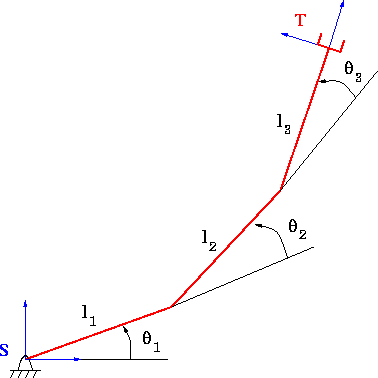University of Notre Dame
Aerospace and Mechanical Engineering
ME 469: Introduction to Robotics
Homework 5
B. Goodwine
Spring, 1999 |
Issued: March 15, 1999
Due: March 19, 1999 |
Unless otherwise indicated, all the problems are from the
course text, Craig, Introduction to Robotics. Unless
otherwise indicated, each problem is worth 10 points.
- Each project group must turn in a summary of the work
accomplished to date on Project
2. Attach this to the homework for only one
group member -- everyone will get the same credit.
- In class, singularities were presented as a generally bad
thing since very large joint velocities were required near them.
However, they are good in the sense that they maximize
mechanical advantage. Show this for the mechanism from the
previous homework illustrated below by finding a large force
(and/or torque) near one of the singular configurations that
requires very small joint torques to maintain.

- In Homework 2, you determined the forward kinematics for
the mechanism in problem 3.18, Figure 3.38 and in the last
homework you computed the Jacobian and one singular
configuration. Again assuming that we are interested in the
(x,y,z) location of the end effector if each joint angle
is 30o, and a force, F = (25,25,25) is applied at the
origin of the end effector frame, what are the joint torques
required to maintain the force?
- In Homework 2, you determined the forward kinematics for
the mechanism in problem 3.20, Figure 3.40 and in the last
homework you computed its Jacobian and one singular
configuration. Again assuming that we are interested in the
(x,y,z) location of the end effector if each joint angle
is 30o, and a force, F = (25,25,25) is applied at the
origin of the end effector frame, what are the joint torques
required to maintain the force?
- In Homework 3, you determined the forward kinematics for
the mechanism in problem 3.21, Figure 3.41. Assume that we are
interested in the (x,y,z) location of the end effector.
What are the singular configurations for this mechanism?
-
Consider the four dimensional SCARA type robot considered in
class last week. Assume that each of the three rotational
joints is at
30o, and the prismatic joint is at the reference
configuration, i.e., theta_4 = 0.
- What is the direction of the maximum mechanical
advantage?
- What is the direction of the maximum velocity amplitude?
Last updated: March 15, 1999.
B. Goodwine (jgoodwin@nd.edu)

